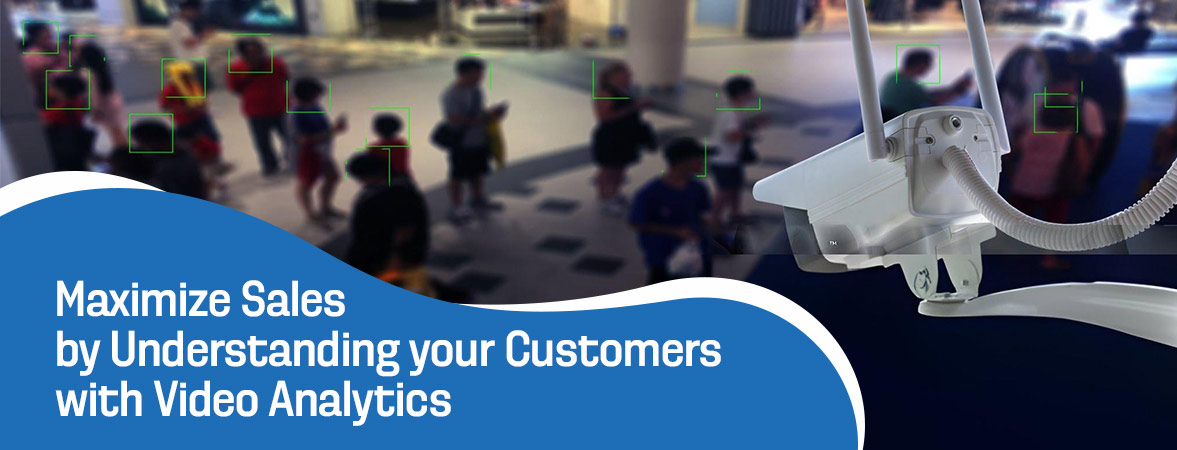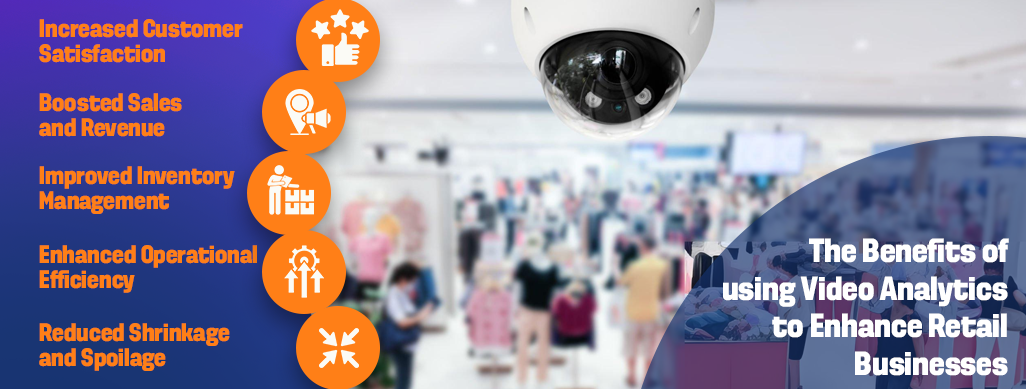
We use cookies to ensure that we give you the best experience on our website.
By using this site, you agree to our use of cookies. Find out more.
This blog discusses how retailers can apply video analytics capabilities to maximize revenues by gaining a deeper understanding of their target audiences.

In today's highly competitive retail environment, it has become essential for businesses to gain insights into customer behavior and preferences within physical stores. Video analytics solutions offered by leading companies are empowering retailers to track, analyze and understand their customers like never before.
By leveraging advanced computer vision and AI technologies, retailers can now derive actionable analytics from surveillance camera feeds installed across stores. This not only helps provide operational efficiencies but also helps boost sales and satisfaction levels. This blog discusses how retailers can apply video analytics capabilities to maximize revenues by gaining a deeper understanding of their target audiences.
Video analytics refers to the application of advanced AI and computer vision techniques to interpret and derive meaningful insights from video data. Typically, video analytics solutions involve installing surveillance cameras throughout retail stores. These cameras continuously capture live video streams of customer and operational activities on the store floor.
The video data is then fed into sophisticated algorithms that can automatically analyze visual elements like images, motion, color, objects and behaviors visible in the videos. The algorithms are trained to recognize, classify and track people, products, assets and events. Powerful analytics are used to surface patterns, generate metrics and key performance indicators.
This helps provide insights into customer buying patterns, operational bottlenecks, inventory levels and more. Retailers can leverage such real-time, data-driven insights from their visual assets to optimize strategic decision making.
Here are some examples of video analytics solutions for retail businesses:
By analyzing in-store video footage, retailers can gain valuable insights into shopper journeys, dwell times in different aisles, repeat visits to particular products and overall store traffic patterns. With video analytics solutions, they can track specific customer behaviors like the time spent browsing in each category, add-to-cart gestures, unsuccessful searches or pick-up and put-back actions.
This behavioral data when integrated with POS transactions allows identifying best-selling products and customer purchase preferences. Retailers can then customize their merchandising, pricing and promotion strategies according to the identified customer segments. For example, frequently purchased items can be kept in prominent display areas, impulse buy products placed near cash counters, and endcaps and multi-buy offers created for favorite categories.
Video analytics also provides a comprehensive view of shopper footfalls across different store zones and timings of the day. With this traffic analysis data, retailers can optimize staffing, product replenishment and display space allocation according to peak and non-peak hours. They can also identify under-utilized areas for repurposing or redesigning the store layout to divert higher footfalls.
Customization further extends to tailoring the signage, browsing guides and product recommendations according to gender, age and other attributes of regular customers in different store sections. This helps boost basket sizes and conversion rates by turning shopper browsing into informed buying decisions.
Video analytics allows retailers to precisely measure the effectiveness of new product launches, seasonal collections, trial promotions as well as ongoing product merchandising strategies. By correlating video inputs of customer engagement with products to sales data, they can analyze which specific SKUs or inventory displays are drawing highest attention, pick rates and conversions.
This provides real-time feedback to tweak promotion strategies and fine-tune line planning to better meet consumer demands. Out-of-stock or slow-moving items can also be quickly identified to rearrange stock replenishment. Analytics further helps determine the optimal shelf space and fixture placement for top-selling items that maximizes their visibility and buyers.
Promotions too can be rigorously evaluated through video insights. Footage of customer pausing or spending extended time near signage helps verify the reach and readership of various signage designs. Linking it with receipt-level purchase records reveals if browsing resulted in actual trial. Comparing pre-and post-promotion customer journeys reflects the impact on brand consideration and repurchase.
Retailers can hence scientifically assess varied offer types like price-offs, free samples, combo deals for resetting strategies. Under-performing campaigns can be repurposed or withdrawn early to optimize budgets. The feedback ensures highest returns from all future marketing dollars spent.
Video analytics provides real-time insights into inventory levels across store sections and shelves. Using computer vision, retailers can track the movement of products from shelf to cart. This helps detect gaps on shelves as soon as they occur to ensure out of stock situations are addressed immediately. Shelf heatmaps revealing fast moving versus slow moving areas allow corrective action like replenishment or reallocation.
Precise counts of stock-ins and retrieval times from backroom helps streamline warehouse fulfilment too. Managers can remotely monitor store conditions from headquarters and centrally replenish popular items. This scientific approach improves availability while reducing excess stocking and lost sales.
In addition, video can optimise daily store operations. It provides a bird's eye view to monitor checkout queues, identify if congestion is building up and accordingly assign additional staff. Footage is also useful to track cleaning, shelving and merchandising routines for adherence. This ensures consistent customer experiences.
Managers can even view live feeds for issues like accidents, theft that impact operations. Integration of video with other IoT sensors allows predictive analysis. For example, coolers struggling to maintain temperature alerts can immediately trigger preventive maintenance. The optimised processes and proactive issue resolution enhances productivity across levels.
Here are some of the key benefits of using video analytics to enhance retail businesses:

One of the key benefits of leveraging video analytics is that it allows retailers to gain deeper insights into their customers and better understand their shopping behaviors, pain points and preferences. Armed with this behavioral data, retailers can tailor the entire customer experience from the minute customers enter the store. They can optimize product placements, merchandising and signage according to customer journeys.
Customized recommendations, service and checkout experiences also improve based on customer attributes. This level of personalization increases customer satisfaction significantly. Not only do customers receive a smoother and more seamless shopping experience, but their needs are also anticipated proactively. The result is higher customer loyalty, engagement and retention rates - all of which are invaluable for any retail business.
By leveraging video footage to analyze shopper behavior and engagement with products, retailers gain actionable insights into the factors that influence purchasing decisions as well as the performance of various sales strategies. This helps optimize critical revenue drivers like shelf placement, pricing, promotions and assortment planning. For example, popular items can be given priority display space based on traffic density and dwell time data. Promotions can be tailored by demographic attributes.
Test-and-learn approaches also allow determining the optimal level of features, discounts and variety for maximizing conversion rates. Through continuous refinements informed by video analytics, retailers can significantly boost sales volumes as well as profit margins over time. The results are visible on the bottom line as increased revenue and higher returns on marketing investments.
Leveraging image recognition technology on stored video footage enables retailers to remotely track product movements, shelf availability and replenishment needs in real-time across all store locations and SKUs. Out-of-stock items are instantly identified and replenished to avoid lost sales. Precise counting of stocks entering and exiting storage assists with demand forecasting and ensures optimal inventory levels at different times of the day and season.
Fewer excesses and shortages reduce warehousing and markdown costs. Live shelf heatmaps help pre-empt stockouts with proactive rebalancing between fast and slow-moving sections. This results in improved customer service levels through higher in-stocks. Overall, incorporating automated inventory intelligence aids managers in making quicker, data-backed decisions to efficiently manage working capital and enhance inventory turns.
With computer vision and AI-based video analytics solutions from companies in India, retailers are now able to remotely monitor daily store operations with greater visibility and control. Solutions allow tracking staff presence, workflows, customer queues and compliance to SOPs in real-time. Companies like Anthropic analyze this feed to identify lapses or inefficiencies. If congestion is detected, additional associates can be deployed proactively via mobile alerts to reduce wait times.
Live diagnostics of equipment like coolers also helps schedule pre-emptive maintenance by service technicians. Out-of-stock items are swiftly replenished to optimal levels. Such optimization of processes and proactive issue management enhances staff productivity, turnover and overall store operations significantly. The data further helps design standard procedures for consistent customer service.
video analytics helps reduce costs for retailers is by minimizing shrinkage and spoilage within stores. Shrinkage refers to inventory lost due to issues like theft, damages or recording errors. This can amount to significant losses for businesses. With video surveillance cameras installed across stores, analytics solutions can closely monitor customer and employee movements.
Any suspicious or criminal activities like theft can be detected quickly by analyzing visuals. Early detection allows retailers to prevent further losses. Video analytics also enables remote scanning of product aisles. It can identify expired or damaged products that need to be removed from shelves immediately.
Continuous temperature and humidity monitoring through videos improves storage compliance and reduces food spoilage. Together, these capabilities powered by video data help retailers reduce shrinkage and spoilage, thereby directly impacting their overall profitability margins.
Here are some of the key challenges of applying video analytics in retail businesses:
Video analytics presents a major opportunity for retailers to optimize strategies, engage customers and future-proof their businesses. While adopting such new-age solutions also poses some implementation challenges, the potential benefits are immense. Leading video analytics companies in India are at the forefront of developing specialized solutions tailored for the retail industry. With computer vision and AI advancing rapidly, capabilities will continue to evolve.
Retailers who are able to successfully harness video data insights through collaboration with such analytics providers will be best positioned to enhance the customer experience and outperform competitors in this fast-paced environment. Video analytics promises to be a game-changer for maximizing sales through deep customer understanding. Retailers should explore offerings from top video analytics companies in India to realize these opportunities.
Leave a Comment
Your email address will not be published.